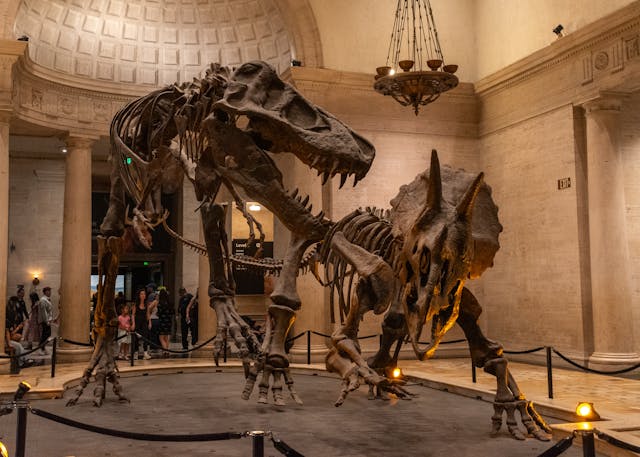
Were dinosaurs warm-blooded or cold-blooded? The majority of dinosaurs were most likely warm-blooded.
“Dinosaur” comes form the Greek “deinos”, which means terrible, and “sauros”, which means lizards. They are terrible lizards, which would lead many people to think that they were cold-blooded, as most lizards are today. Lizards have evolved to be cold-blooded because it lets them survive on much less food than they would need if they were warm-blooded. A warm-blooded animal, such as us, needs to consume a lot of calories just to heat the body. As much as 60% of the calories we eat every day go to jut keeping our bodies warm. Cold-blooded animals can get by without eating as much because they don’t need to heat themselves. That means they can eat less, and they also need less oxygen as well. However, dinosaurs and lizards both come from the group Reptilia, but dinosaurs are not lizards, just as their ancestors, birds, are not lizards.
Because they were called terrible lizards, many people assume that dinosaurs would be cold-blooded and therefore very slow and sluggish. However, it turns out that they were most likely warm-blooded. There is no way paleontologists can definitely know the answer to this because they only thing they have to work with are fossils, but there are two possible proofs for this theory. The first is the sheer size of some of the dinosaurs. Logically, if we need 60% of our consumed calories to go to heating, a large dinosaur, such as a diplodocus would need to consume an impossible amount of food every day. That turns out not to be true because of gigantothermy. The larger an animal is, the less it needs to heat itself and the smaller an animal is, the more energy it needs to use for heating. This is because as an animal gets bigger, the volume of the animal increases faster than its surface area does. This is called the volume to surface area ratio. With a squirrel, the volume to surface area ratio is 6093:1. They lose heat so fast they have to constantly eat. This is the reason why squirrels in the Arctic are larger than squirrels in hotter climes. For an elephant it is 283:1. A diplodocus would be much lower than an elephant. That means they cannot lose much heat through their skin because they have far more volume holding heat in that surface area losing heat. A diplodocus would not have had to eat much to stay warm because of this. In fact, they probably had more trouble staying cool than keeping warm.
The second is the amount of oxygen that the dinosaurs consumed. Because heat is produced when animals burn glucose in the presence of oxygen in our bodies, warm-blooded animals need more oxygen than cold-blooded animals. Crocodiles can hold their breath for several hours, even longer if the water is colder, because they don’t need oxygen to make heat. Because paleontologists only have dinosaur fossils to go on, it would seem impossible to know how much oxygen a dinosaur required, but there is a way of knowing that. When we breathe, we use the oxygen to break down proteins, sugars, and fats in our bodies for energy, and each time it does, some different isotopes and molecular residues are left over. This waste can be trapped in the bones and is very stable and not water soluble, meaning it is fossilized along with the bones themselves. Paleontologists can analyze the bones and they can use infrared spectroscopy to analyze the isotopes and residues in the bones. Infrared spectroscopy works because different compounds absorb different amounts of infrared radiation. The scientists looked at many different types of dinosaur bones and they compared the results they got with the residue in the bones of modern animals and they found that the dinosaurs generally had very high metabolic rates, consistent with warm-blooded animals.
However, their research showed that one group of dinosaurs, the ornithischians, had very low metabolic rates and might have been cold-blooded. Triceratops and Stegosaurus are two examples of these. They would have needed to sit out in the sun to warm up before they could do anything, but they wouldn’t have had to eat as much to survive. One disadvantage of cold-blooded dinosaurs would have been that they were limited to where they could live. They would have needed to stay in hot places, near the tropics, and would not have been able to spread out across the world. Warm-blooded dinosaurs could live anywhere, so long as there was a source of food. And this is what I learned today.
Sources
https://www.usgs.gov/faqs/were-dinosaurs-warm-blooded-or-cold-blooded
https://en.wikipedia.org/wiki/Physiology_of_dinosaurs
https://en.wikipedia.org/wiki/Infrared_spectroscopy
https://www.usatoday.com/story/news/animalkind/2023/05/30/are-birds-dinosaurs-reptiles/70199383007
https://www.ncbi.nlm.nih.gov/books/NBK538294
https://en.wikipedia.org/wiki/Gigantothermy
https://en.wikipedia.org/wiki/Surface-area-to-volume_ratio
Photo by Allan Ramirez: https://www.pexels.com/photo/dinosaurs-nhm-los-angeles-26898334/
